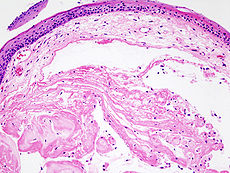- Vocal fold nodule
-
Vocal cord nodule Classification and external resources 
Histopathologic image of vocal fold nodule or polyp. Biopsy specimen. H & E stain.ICD-10 J38.2 ICD-9 478.5 DiseasesDB 29628 A vocal cord nodule is a mass of tissue that grows on the vocal folds (vocal cords). Typically, this mass will appear on the junction of the anterior and middle two-thirds of the vocal fold, where contact is most forceful.
A vocal cord nodule reduces or obstructs the ability of the vocal folds to create the rapid changes in air pressure which generate human speech. Symptoms include hoarseness of speech, painful speech production, frequent vocal breaks, and reduced vocal range. Vocal fold nodules develop mostly in adult females, and children of both sexes.[1]
The nodules appear as symmetrical swellings on both sides of the vocal cords. The cause of these formations are usually strenuous or abusive voice practices such as yelling and coughing. Persons who are often susceptible are those who use their voice constantly in a loud environment. Examples include teachers, cheerleaders, politicians, actors, preachers, singers, and military drill instructors.
Contents
Prognosis
Vocal cord nodules, although they can certainly impair one's speaking and singing ability, rarely harm one's general health. Indeed, the psychological trauma of being diagnosed with nodules—a trauma affecting those especially whose professional success depends on consistently producing a rich and powerful vocal tone (e.g. singers, actors, litigation lawyers, broadcasters)—typically dwarfs the limited systemic and even otolaryngological effects.
Treatment
Treatment, or voice rehabilitation, usually involves vocal training, speech therapy, and, occasionally, vocal rest. In rare cases, surgery may be required. Removal of vocal cord nodules is a relatively safe and minor surgery. However, those who sing professionally or otherwise should take serious consideration before having surgery as it can affect the ability to sustain notes, as well as alter the vocal range. One example of this is Julie Andrews, who lost much of her singing ability after undergoing vocal nodule surgery in 1997. While the patient is subdued under general anesthesia, long thin scissors and scalpels are used to remove the nodules, or CO2 surgical lasers might be used which are very effective in such cases. The best preventive steps seem to be wrapped up in the study of vocology, the science and practice of voice habilitation.
Symptoms of vocal nodules include vocal fatigue and hoarseness or breathiness. Hoarseness or breathiness that lasts for more than two weeks may signal a voice disorder and should be followed up with an appointment with an otolaryngologist.
See also
References
- ^ Blake Simpson, Clark Rosen, Hans Von Leden, Robert H. Ossoff (2008) Operative Techniques in Laryngology
External links
- Vocal disorder support group (VoiceMatters.net)
- Voice therapy for adults: vocal nodules, voice strain, Caroline Bowen, PhD
- Voice therapy for children (1), Caroline Bowen, PhD
- Voice therapy for children (2), Caroline Bowen, PhD
Categories:- Voice disorders
- Vocal fold disorders
Wikimedia Foundation. 2010.
